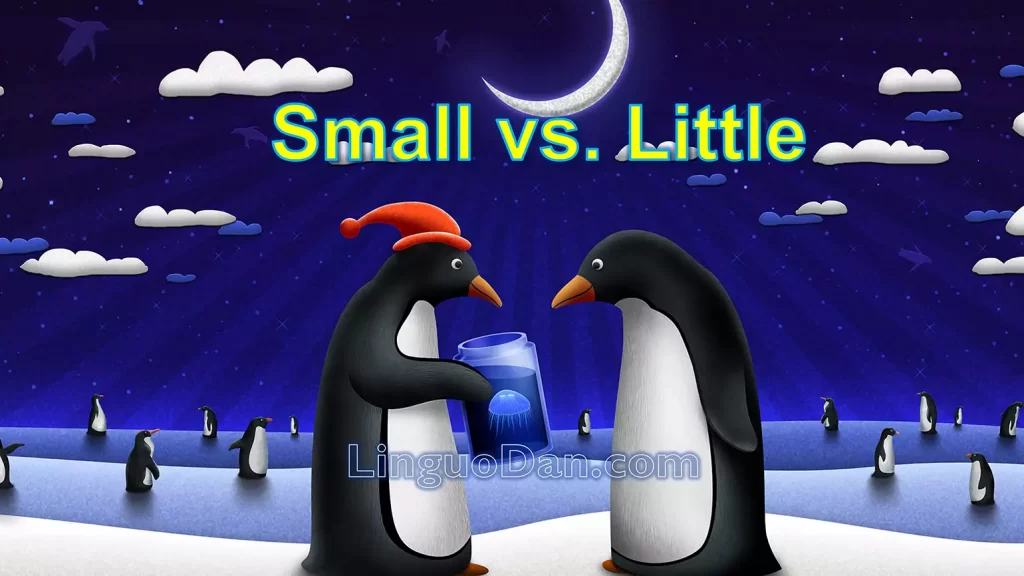Difference Between “Small” and “Little” in English

Small vs. Little: Understanding the Difference
When learning English, it’s common to come across words that seem similar but have distinct meanings (synonyms). Two such words are “small” [smɔːl] and “little” [ˈlɪt.əl]. While they may appear to be interchangeable, they actually have subtle differences in usage and connotation. In this article, we will delve into the dissimilarities between these two adjectives and help you gain a better understanding of when to use “small” or “little.”
Defining Small and Little: Before we explore the differences, let’s establish the basic definitions of “small” and “little.” Both words generally refer to something of a diminutive size or quantity. However, their nuances lie in the context and connotation they carry.
- Small is used to describe the size or dimensions of an object. It refers to something that is not large in physical magnitude or extent. For example, a small car, a small house, or a small piece of cake. It focuses on relative size and can be used to compare objects within a specific category.
- Little: On the other hand, “little” primarily emphasizes the amount or degree of something. It refers to a small quantity or a minimal size. “Little” is often used when discussing abstract concepts or intangible qualities, such as emotions, time, or significance. For instance, a little patience, a little time, or a little knowledge. It suggests a sense of scarcity or limitation.
Distinctions in Usage: While “small” and “little” can both be used to describe size or quantity, they have different connotations. “Small” generally denotes a physical size that is comparatively smaller within a specific category, while “little” suggests a scarcity or insufficiency. Understanding these connotations will help you choose the appropriate word based on the desired meaning and context.
Position in a Clause
The placement of “small” and “little” within a sentence can vary. “Small” is commonly used before a noun, indicating the size or dimensions of the object. For example, “a small house” or “a small car.” On the other hand, “little” is often placed before an uncountable noun or an adjective, emphasizing the quantity or degree. For instance, “little water” or “little progress.”
Different Usage Contexts: To gain a clearer understanding, let’s explore some specific usage contexts where “small” and “little” are typically employed.
- Physical Size: When describing the physical size of objects, “small” is the more commonly used term. For instance, a small dog, a small table, or a small room. The focus here is on the relative dimensions of the object being referred to.
- Quantity or Degree: When discussing the amount or degree of something, “little” is often the appropriate choice. For example, a little water, a little information, or a little patience. It highlights a small or insufficient quantity or degree of the given attribute.
- Comparisons: “Small” is frequently used in comparative contexts, where the relative size of objects within a specific category is compared. For instance, a small apple compared to a large apple. On the other hand, “little” is not commonly used for comparisons of physical size but is more suitable for comparisons of quantity or degree. For example, little progress compared to significant progress.
- Informal and Emotional Expressions: While both words can be used to express informality or emotional connotations, “little” tends to add a touch of endearment or tenderness to the description. For instance, “a small favor” is neutral, while “a little favor” implies a request made in a more affectionate manner.
Key Differences
-
Emotional Undertone: “Little” also brings an emotional context or subjective judgement that “small” does not have. For example, “The little girl is scared.” Here “little” evokes a feeling of sympathy.
-
Use with Unquantifiable Nouns: “Little” often works with unquantifiable or non-countable nouns, while “small” is often used with countable ones. Compare “There is little hope for a change” (not: “small hope”) and “He is a small boy” (not: “little boy”).
-
Formality: “Small” is more formal and commonly used in written English and formal speeches, while “little” is more colloquially used in daily conversations.
-
Degree of Smallness: “Little” typically implies a smaller degree than “small”. Both “small” and “little” can be used in comparative and superlative forms, but their usage and connotations vary. “Smaller” and “smallest” are comparative and superlative forms of “small” and focus on physical size. For example, “a smaller car” or “the smallest house.” On the other hand, “less” and “least” are used as the comparative and superlative forms of “little” to emphasize the limited quantity or degree. For instance, “less information” or “the least progress.”
In summary, the words “small” and “little” may seem similar, but they have distinct uses and connotations. “Small” primarily refers to physical size or dimensions, while “little” focuses on quantity or degree. By understanding their subtle differences, you can enhance your English language skills and communicate more precisely. Remember, practice and exposure to varied contexts will help solidify your grasp of these nuanced distinctions, enabling you to express yourself effectively in English.